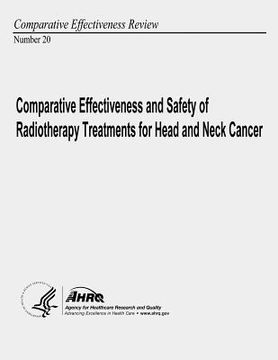Comparative Effectiveness and Safety of Radiotherapy Treatments for Head and Neck Cancer: Comparative Effectiveness Review Number 20 (en Inglés)
Reseña del libro "Comparative Effectiveness and Safety of Radiotherapy Treatments for Head and Neck Cancer: Comparative Effectiveness Review Number 20 (en Inglés)"
This is a review of alternative radiation therapy (RT) modalities in the treatment of head and neck cancer including: conventional or two-dimensional (2DRT), three-dimensional conformal (3DCRT), intensity-modulated (IMRT), and proton beam radiotherapy. Key questions that will be addressed are whether any of these modalities is more effective than the others: (1) in reducing normal tissue toxicity and adverse events, and improving quality of life; (2) in improving local tumor control, time to disease progression, and survival; (3) when used in certain anatomic locations or patient subpopulations; and, finally, (4) whether there is more variation in patient outcomes with any modality secondary to user experience, treatment planning, or target volumes. Head and neck cancers, specifically those arising in the oral cavity, larynx, hypopharynx, oropharynx, nasopharynx, paranasal sinuses/nasal cavity, salivary glands and occult primaries, account for approximately 3 to 5% of cancers in the U.S. Major risk factors for the development of head and neck cancer include tobacco and alcohol abuse, with other less-common risk factors including occupational exposures, nutritional deficiencies, and poor oral health. Viral etiologies have also been established, with human papillomavirus infection appearing to be a risk factor, particularly within the oropharynx, in younger people without a history of tobacco or alcohol abuse. In addition, an association has been made between Epstein-Barr virus and nasopharyngeal cancer. The main challenge in radiation therapy for cancer is to attain the highest probability of tumor control or cure with the least amount of morbidity and toxicity to normal surrounding tissues. Radiation therapy designs have evolved over the past 20 years from being based on two-dimensional (2D) to three-dimensional (3D) images, incorporating increasingly complex computer algorithms. 2D radiotherapy consists of a single beam from one to four directions with the radiation fields designed on 2D fluoroscopic simulation images, whereas 3D conformal radiotherapy (CRT) employs computed tomography (CT) simulation. Intensity-modulated radiotherapy (IMRT) allows for the modulation of both the number of fields and the intensity of radiation within each field, allowing for greater control of the dose distribution to the target. Although proton beam therapy has been used to treat tumors for more than 50 years, it has been used mostly in the treatment of prostate cancer. Radiation is associated with early and late toxicities, which can have a profound effect on a patient's quality of life, and chemoradiation may be associated with enhancement of these toxicities (particularly mucositis and xerostomia). Therapy-related toxicities are particularly relevant in the treatment of head and neck cancer because of the close proximity of many important dose-limiting normal tissues. Treatment effects can affect basic functions like chewing, swallowing, and breathing, and the senses (e.g., taste, smell, and hearing), and can significantly alter appearance and voice. This review addresses four key questions to compare alternative radiotherapy modalities in the treatment of head and neck cancer. Four alternative radiotherapy modalities will be reviewed: IMRT, 3DCRT, 2DRT, and proton beam. 1. What is the comparative effectiveness of IMRT, 3DCRT, 2DRT, and proton beam therapy regarding adverse events and quality of life? 2. What is the comparative effectiveness of IMRT, 3DCRT, 2DRT, and proton beam therapy regarding tumor control and patient survival? 3. Are there differences in comparative effectiveness of IMRT, 3DCRT, 2DRT, and proton beam therapy for specific patient and tumor characteristics? 4. Is there variation in comparative effectiveness of IMRT, 3DCRT, 2DRT, and proton beam therapy because of differences in user experience, target volume delineation, or dosimetric parameters?

